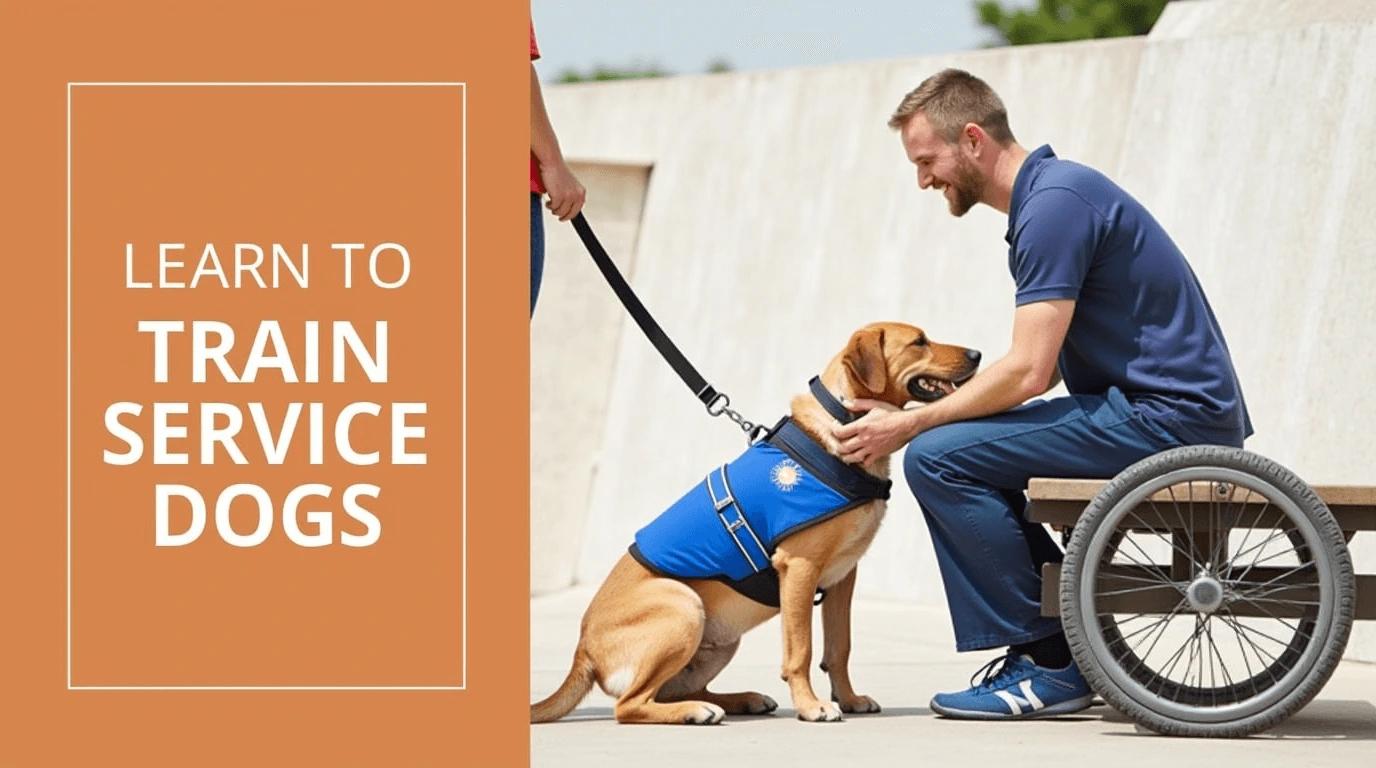learn to train service dogs Starting a journey is always exciting. For those who want to help others, training service dogs is a rewarding path. It combines compassion with professional growth. You can help people with disabilities live more independently.
Service dog training is more than just teaching dogs tricks. It’s about building strong partnerships. These partnerships help people regain their dignity, mobility, and confidence. A good training program teaches you how to make this happen.
If you’re looking for a fulfilling career or just want to learn, there are courses for you. These programs mix science with understanding dogs and humans. They help you unlock your potential as a trainer.
Key Takeaways
- Service dog training requires specialized skills and comprehensive understanding
- Professional courses offer structured pathways to become a skilled trainer
- Training programs focus on both dog behavior and handler requirements
- Service dogs play crucial roles in supporting individuals with disabilities
- Effective training involves obedience, task-specific skills, and public access preparation
- Certification can enhance credibility in the service dog training field
Understanding Service Dog Training Fundamentals
Service dog training is a special field that needs patience, knowledge, and skill. When you start service dog training classes, you enter a world of complex communication and behavior change. It’s more than just basic dog training.
Professional training aims to make dogs with special skills to help people with certain needs. These dogs learn important skills through structured learning.

Basic Training Concepts and Principles
Good service dog training follows a few key rules:
- Positive reinforcement techniques
- Consistent skill repetition
- Precision in command execution
- Building reliable behavioral patterns
Every dog learns in their own way. Training usually takes at least 6 weeks in basic classes before moving to specialized work.
Essential Skills for Service Dog Training
To succeed in service dog training, trainers need certain skills:
- Exceptional observation skills
- Patience during skill development
- Adaptability to individual dog needs
- Understanding of canine psychology
Dogs in service programs must have stable temperaments and good manners. The AKC Canine Good Citizen certification is a key test for starting.
Understanding Dog Body Language and Communication
Knowing how to read dog body language is key in service dog training. Trainers must understand subtle signs and use clear communication. Verbal cues like “Yes” for success and “Okay” to release are used for clear interactions.
Effective communication within 1.7 seconds ensures dogs can accurately associate commands with desired behaviors.
Learn to Train Service Dogs: A Comprehensive Guide
Training a service dog needs dedication, patience, and a clear plan. This journey is both tough and fulfilling. It usually takes at least two years, with many important steps.
Key stages of service dog handler training include:
- Socialization: The most crucial foundation for future success
- Cooperative Care & Home Manners
- Outside Manners
- Public Manners
- Task-Specific Training
- Public Access Skills
Knowing the law is key when training a service dog. The Americans with Disabilities Act lets you train your dog yourself. You must make sure your dog behaves well in public and does specific tasks to help you.
Getting help from a pro can make a big difference. While training yourself can save money, a good trainer lays a strong base. They teach dogs to do important tasks for people with different needs, like mobility issues or autism.
Success in service dog training requires patience, compassion, and a deep understanding of canine behavior and communication.
Every service dog is special. Training them means they learn to handle complex situations and support their handlers. With a detailed training plan, you can create a life-changing partnership with your service dog.
Service Dog Training Program Structure and Requirements
Starting a service dog training program needs careful planning and commitment. It’s a journey to become a professional service dog trainer. You must understand the training structure and meet specific requirements.
Going through a service dog trainer course is demanding. It requires dedication and specialized knowledge. Prospective trainers face an intense learning experience, more than regular dog training.
Course Modules and Content Overview
A typical service dog training program has several key parts:
- Basic obedience skills development
- Advanced task-specific training
- Public access and socialization techniques
- Disability-specific support training
- Handler interaction and communication strategies
Training Duration and Time Commitment
The program usually lasts 18-24 months. Aspiring trainers should expect:
- Initial assessment phase: 2-3 months
- Intensive skill development: 12-15 months
- Final certification and evaluation: 3-4 months
Prerequisites and Eligibility Criteria
Not everyone can become a service dog trainer. Key requirements include:
- Minimum age of 18 years
- Physical fitness to handle and train dogs
- Basic understanding of canine behavior
- Emotional stability and patience
- Commitment to ongoing professional development
About 50% of dogs trying service dog training don’t make it. This shows how tough the training is. It’s crucial to pick the right candidates.
Professional Service Dog Training Certification Options
Finding your way in the service dog world can be tough. The U.S. doesn’t require specific training certifications for service dog trainers. But, getting certified can boost your credibility and skills in this field.
Many respected groups offer courses for service dog trainers. These courses give you the skills to train service dogs for important work.
- Bergin University of Canine Studies offers comprehensive service dog training programs
- The National Education for Assistance Dog Services (NEADS) provides specialized training
- The Service Dog Academy has trained over 300 medical alert dogs
Certification programs have different levels for all experience levels:
| Certification Level | Target Audience | Key Focus |
|---|---|---|
| Level 1 | Beginner Trainers | Foundational Skills |
| Level 2 | Handlers with Disabilities | Self-Training Techniques |
| Level 3 | Experienced Trainers | Advanced Service Dog Training |
When picking a certification program, look at the curriculum. Good programs cover 12 critical modules. These include legal stuff, dog behavior, training methods, and running a business.
Great service dog trainers are patient, caring, and know dogs well. They also solve problems well. With 500,000 Americans needing service dogs and only 10,000 training groups, your skills are crucial.
Legal Requirements and ADA Compliance in Service Dog Training
Understanding the legal side of service dog training is key. You need to know the Americans with Disabilities Act (ADA) and other rules. Learning how to train a service dog means knowing the laws that protect service animal rights.
Understanding Service Dog Rights
The ADA, passed in 1990, protects people with disabilities and their service dogs. Important laws include:
- Service dogs can go into most public places
- You don’t need special papers or tags for them
- Only two questions can be asked about a service dog
Your training should teach that service dogs are working animalslearn to train service dogs , not pets. They have special rights.
Public Access Training Requirements
Training for service dogs is more than just teaching tasks. It’s also about how they behave in public. They need to be able to handle different places well and safely.
- They must know basic obedience
- They should stay calm in crowded areas
- They need to act right when meeting strangers
- They must always listen to their handler’s commands
Handler Responsibilities and Obligations
As a service dog handler,learn to train service dogs you have important duties. Your dog must:
- Be trained to do specific tasks for your disability
- Stay under your control in public
- Be clean and well-behaved
- Focus on helping you
Breaking these rules can lead to big fines, up to $10,000 in some places.
Advanced Training Techniques for Service Dogs
Service dog training classes need special techniques beyond basic obedience. Advanced training helps dogs learn complex skills.learn to train service dogs These skills are crucial for supporting handlers with specific needs. Your training should focus on solving problems and performing detailed tasks.
Key advanced training techniques include:
- Scent work detection for medical alert tasks
- Complex task chain development
- Adaptive behavior modification
- Specialized sensory skill training
Professional trainers create training plans just for each dog.learn to train service dogs Dogs learn to do specific tasks like:
- Medical emergency recognition
- Mobility assistance techniques
- Psychiatric support interventions
- Environmental navigation skills
Training a service dog needs patience, consistency, and knowing how dogs learn. Use positive reinforcement to build confidence and reliability.learn to train service dogs Advanced techniques require careful skill building, so dogs can meet different handler needs.
The most effective service dogs demonstrate exceptional problem-solving abilities and emotional intelligence.
Training plans should match each dog’s personality and the handler’s needs.learn to train service dogs This creates a strong partnership between the service dog and handler.

Task-Specific Training Methods and Applications
Learning to train service dogs is key. They are amazing helpers for people with disabilities. They can do complex tasks that change lives.
To train a service dog, you need to teach specific skills.learn to train service dogs These skills are based on what the handler needs. It takes patience, skill, and knowing what dogs can do.
Medical Alert Training
Medical alert training teaches dogs to spot important health changes.learn to train service dogs They can learn to:
- Detect blood sugar level changes
- Signal seizures are coming
- Find heart rate issues
- Spot hormone level changes
For example, diabetic alert dogs can find blood sugar changes up to 20 minutes before a meter can. They are right about 90% of the time.
Mobility Assistance Skills
Mobility support training helps service dogs help people who can’t move as well. They learn to:
- Help with balance
- Get things that have been dropped
- Open and close doors
- Help with using a wheelchair
Psychiatric Service Tasks
Psychiatric service dogs get special training for mental health. learn to train service dogs Training can cost between $15,000 and $30,000. They learn to:
- Do deep pressure therapy for anxiety
- Stop harmful behaviors
- Help during PTSD episodes
- Remind handlers to take medicine
Training a service dog takes about 200-300 hours. Another 120-150 hours are for specific tasks.
Building a Career as a Service Dog Trainer
Starting a career in service dog training is exciting for dog lovers.learn to train service dogs It’s a chance to change lives with specialized training. Even though there are no strict rules for trainers, you can still become an expert through courses and hands-on experience.
First, learn about the different training levels. The Certified Service Dog Trainer Program has three levels: beginner, handler, and advanced.learn to train service dogs These levels last 10 weeks and cover 12 key training modules.
To succeed, you need patience, compassion, and good communication. The need for service dogs is growing, offering many career chances. Now, online courses help obedience trainers move into this field, opening new doors.
Table of Contents
It’s important to network and keep learning. Stay current with ADA rules, new training methods, and top practices. Working with organizations or starting your own business, you’ll make a big difference in people’s lives. This career is both fulfilling and meaningful.

